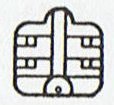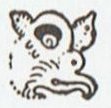|
5. Allen: "Alphard, Alfard, and Alpherd, - Alphart in the Alfonsine Tables and Pherd with Hyde, - are from Al Fard al Shujā', the Solitary One in the Serpent, well describing its position in the sky." Why is it a solitary star? Its position among the rest of the stars in Hydra cannot be the reason I think. Perhaps one should say Alphard is the only star which is easily seen in the 10th hour, all the other are faint. The complete list so far of the stars in the 10th hour:
Miaplacidus and Tureis are also bright stars but they are too far down to be visible under normal circumstances. Alphard is a single great star on the other side of the Milky Way compared to Betelgeuze and submerged only a little beneath the equator of the sky. It marks the neck (turi-uru) of the Sea Dragon and the neck is the first 'joint' named by the Golden Plover: ... Fakataka swims and swims, reaching another land. She goes there and stays on the upraised reef in the freshwater pools on the reef, and there delivers her child, a boy child. She gives him the name Taetagaloa. When the baby is born a golden plover flies over and alights upon the reef. (Kua fanau lā te pepe kae lele mai te tuli oi tū mai i te papa). And so the woman thus names various parts of the child beginning with the name 'the plover' (tuli): neck (tuliulu), elbow (tulilima), knee (tulivae). In the chapter Time Travel I commented: ... Tae-tagaloa means 'not (ta'e) Tagaroa, i.e. we can understand the strange name of the child as 'land', because Tagaroa refers to the sea. His father 'expires' before reaching the new land, but his mother 'swims and swims' and survives the sea. On the freshwater reef (a horizontal flat season) she is giving birth to her man again. Because her man is Sun and her Son is Sun and his living spirit (manu rere) reappears as a golden plover in order to reincarnate himself in the body of the newborn baby boy.
The head of Hydra (the 7 stars rising earlier than the Knot and Alphard) is just above the 'water line' (the sky equator). 6 of them are in the 9th hour and the last (ω) in the 10th hour. Thus ω Hydrae can be said to correspond to Saturn - it is the last of the 7 and also the faintest.
Number 3-14 confirms my interpretation. In chapter Signs I speculated: ... Maybe we should add 104 + 182 = 286 = 11 * 26, i.e. 'one more' than 10 * 26 ... Quite possibly we should also count beyond 2 * 236 = 472 in the G text. Haś in Ga3-14 corresponds to glyph number 260 + 286 = 546 ... And then at Maro I had a more thorough discussion:
|
|||||||||||||||||||||||||||||||||||||||||||||||||||||||||||||||||||||||||||||||||||||||||||||||||||||||||||||||||||||||||||||||||||||||||||||||||||||||||||||||||||||||||||||||||||||||||||||||||||||||||||||||||||||||||||||||||||||||||||||||














